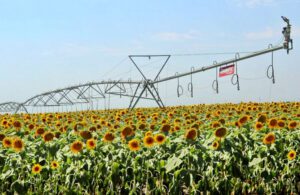
President of Ukraine Volodymyr Zelensky said he expects good news from partner countries regarding arms supplies.
“The United States has confirmed at various levels that modern HIMARS multiple launch rocket systems are being sent to our state. These weapons will really help save the lives of our people and protect our land,” Zelensky said in a video message on Friday night.
He thanked US President Joseph Biden and the American people for such support.
“We also expect good news about the supply of weapons from other partners. For example, today there is a new defense assistance package from Sweden,” the president said, adding that Ukraine is working to bring the volume of deliveries, primarily of modern combat systems, to higher level.

Most oil extraction plants in Ukraine stopped working due to Russia’s military aggression against Ukraine, but in April-May, the plants in the western, central and southern regions of the country began to resume operations due to an increase in sunflower processing margins up to $200/tonne.
“Currently, processors are actively buying sunflower against the backdrop of disappointing production forecasts for the next season… Some plants provide processing services at a price of $80-150/tonne, while others buy sunflower at UAH 15,000-16,500/tonne, receiving a processing margin of up to $200/tonne,” according to the website of the electronic grain exchange GrainTrade.
According to its data, the resumption of the work of Ukrainian oil extraction plants in the western, central and even southern regions of the country is caused by a sharp reduction in the price of sunflower due to difficulties with its export from Ukraine due to the blockade of the country’s seaports by Russian ships.
GrainTrade notes that the price of sunflower will continue to grow, as it is under pressure from its significant stocks from producers and processors, as well as difficulties with the export of oil products – sunflower meal and cake.
“Now it is difficult for processors to sell meal and cake to European consumers due to the increase in logistics costs and falling prices in the EU amid an increase in the supply of Ukrainian products. At the same time, producers are in no hurry to sell sunflower seeds at low prices, expecting an increase in production costs in the new season,” the grain exchange said.

The American company Palantir, a developer of data analysis software for organizations, is ready to become a partner of Ukraine in the defense, security and digital technologies sector, Deputy Prime Minister – Minister of Digital Transformation of Ukraine Mykhailo Fedorov said.
“Today, together with Volodymyr Zelensky, we’ve met with Palantir CEO Alex Karp. Palantir is the world leader in the development of data analysis software. The company’s products are used by the US Department of Defense, large investment banks and hedge funds. I would like to thank Palantir CEO Alex Karp, who responded to the invitation of the Ministry of Digital Transformation and was the first of the general directors of large Western corporations to personally come to Ukraine,” the minister said on Telegram.
According to him, the company is ready to open an office in Ukraine and start joint developments with Ukrainian specialists.
“Further cooperation with Palantir will help strengthen our army and defeat the enemy as soon as possible, because technology plays a big role in modern warfare,” Fedorov stressed.
Palantir is an American company that develops data analysis software for organizations, the main customers are intelligence agencies, investment banks, and hedge funds. It was founded in 2003 by a group of investors who came from PayPal.

The U.S. will fully resume the work of its embassy in Ukraine, U.S. Ambassador to Ukraine Bridget Brink said.
“We will fully resume the work of the U.S. Embassy and fully resume the work of its staff,” Brink said at a briefing in Kyiv on Thursday.

American University Kyiv (AUK, American University Kyiv) with a planned investment of $33 million, which announced the start of work in Kyiv a few weeks before the start of the war, confirmed the fall enrollment of students for bachelor’s and master’s programs.
“Realizing the challenges of the brutal Russian war and the need for many Ukrainians to leave their homes, AUC is launching autumn training programs in an online format. Moreover, AUC is offering guaranteed scholarships of 60-75% to all enrolled (in 2022) students…”, – according to a press release from the university on Thursday.
As the agency “Interfax-Ukraine” was specified in the AUC, the first enrollment for bachelor’s programs will be 100, and for master’s programs – 60 students.
The scholarship for a two-year bachelor’s program will be 75%, for a one-year master’s program – 60%, with tuition fees of $8,000 and $9,000 per year, respectively.
“Education is the foundation of Ukraine’s future prosperity… Our unprecedented wartime scholarships are AUC’s contribution to Ukraine’s victory and future revival,” University President Rick Shengrove said in the release.
According to him, we are talking about three bachelor’s programs – Business Management, Global Management and Software Engineering and two master’s programs – Global Management and Software Engineering.
As reported, at a presentation in early February this year, AUC announced plans to increase the number of students to 3.8 thousand in 5 years, and to 7.2 thousand in 10 years. The university entered into a 25-year license agreement with Arizona State University ( ASU) is one of the largest universities in the US with over 135,000 students.
In February, the acceptance of documents began in order to launch the master’s programs in business management and IT Global Management and Software Engineering from March, and from April – lifelong learning programs. It was supposed that this year there will be 370 students in AUC. Undergraduate and graduate studies will be conducted in English. The university will offer a double degree – Ukrainian and American, for which it will be necessary to study at ASU full-time or online for three or four years of undergraduate or master’s degree at AUC.
Of the planned investments of $33 million, $6 million will be invested by ASC in the renovation of the building of the capital’s River Port with an area of 7.75 thousand square meters. m, which the university leased for 10 years with the right to renew.
In Ukraine, the AUC’s founding partners are: EPAM Systems, BGV Group Management, DTEK Academy, Brain, Channel Georgian Consulting, Georgian American University.

The Club of Experts YouTube channel has released a new video dedicated to the prospects for the development of the volunteer movement in Ukraine after the start of the war and solving the main problems that our citizens may face when bringing humanitarian aid to Ukraine.
According to Maxim Urakin, the founder of the Club of Experts, the humanitarian situation that arose in Ukraine after the outbreak of hostilities forced tens of thousands of people to volunteer.
“At the same time, many people faced with the incomprehensibility of the processes of crossing the border and importing certain goods into the country,” the expert emphasized.
In his commentary, the head of the International Technology Transfer Association (ITTA), Artem Goncharenko, noted that when organizing volunteer assistance, one should understand what needs the recipients of volunteer assistance have. At the same time, in his opinion, individual and general requests of both military and ordinary citizens should be distributed.
“It is important to understand that we cannot offer a single universal solution. Need a personal approach (…). At the same time, different volunteer organizations should unite to improve the coordination of work,” he said.
In turn, Evgenia Litvinova, Chair of the Ukrainian Exporters’ Club, analyzed the latest legislative changes that have greatly simplified the delivery of international humanitarian aid to Ukraine.
In their presentation, the experts provided a detailed explanation on the following problematic issues:
– Who has the right to bring humanitarian aid to Ukraine?
– On the basis of what documents can humanitarian aid be imported?
– What changes have been introduced when filling out customs declarations?
– What shipping documents do you need to have when crossing the border?
For more details, see the video on the YouTube channel “Expert Club” at the link:
EXPERT CLUB, GONCHARENKO, HUMANITARIAN AID, IMPORT, LITVINOVA, URAKIN